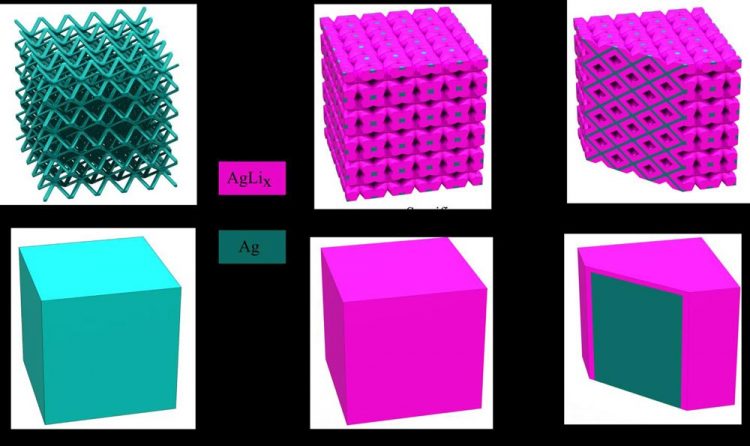3D printing the next generation of batteries

Lattice architecture can provide channels for effective transportation of electrolyte inside the volume of material, while for the cube electrode, most of the material will not be exposed to the electrolyte. The cross-section view shows the silver mesh enabling the charge (Li+ ions) transportation to the current collector and how most of the printed material has been utilized. Credit: Rahul Panat, Carnegie Mellon University College of Engineering
Lithium-ion battery capacity can be vastly improved if, on the microscale, their electrodes have pores and channels. An interdigitated geometry, though it does allow lithium to transport through the battery efficiently during charging and discharging, is not optimal.
Rahul Panat, an associate professor of mechanical engineering at Carnegie Mellon University, and a team of researchers from Carnegie Mellon in collaboration with Missouri University of Science and Technology have developed a revolutionary new method of 3-D printing battery electrodes that creates a 3-D microlattice structure with controlled porosity. 3-D printing this microlattice structure, the researchers show in a paper published in the journal Additive Manufacturing, vastly improves the capacity and charge-discharge rates for lithium-ion batteries.
“In the case of lithium-ion batteries, the electrodes with porous architectures can lead to higher charge capacities,” says Panat. “This is because such architectures allow the lithium to penetrate through the electrode volume leading to very high electrode utilization, and thereby higher energy storage capacity. In normal batteries, 30-50% of the total electrode volume is unutilized. Our method overcomes this issue by using 3D printing where we create a microlattice electrode architecture that allows the efficient transport of lithium through the entire electrode, which also increases the battery charging rates.”
The additive manufacturing method presented in Panat's paper represents a major advance in printing complex geometries for 3-D battery architectures, as well as an important step toward geometrically optimizing 3-D configurations for electrochemical energy storage. The researchers estimate that this technology will be ready to translate to industrial applications in about 2-3 years.
The microlattice structure (Ag) used as lithium-ion batteries' electrodes was shown to improve battery performance in several ways such as a fourfold increase in specific capacity and a twofold increase in areal capacity when compared to a solid block (Ag) electrode. Furthermore, the electrodes retained their complex 3D lattice structures after forty electrochemical cycles demonstrating their mechanical robustness. The batteries can thus have high capacity for the same weight or alternately, for the same capacity, a vastly reduced weight–which is an important attribute for transportation applications.
The Carnegie Mellon researchers developed their own 3-D printing method to create the porous microlattice architectures while leveraging the existing capabilities of an Aerosol Jet 3-D printing system. The Aerosol Jet system also allows the researchers to print planar sensors and other electronics on a micro-scale, which was deployed at Carnegie Mellon University's College of Engineering earlier this year.
Until now, 3-D printed battery efforts were limited to extrusion-based printing, where a wire of material is extruded from a nozzle, creating continuous structures. Interdigitated structures were possible using this method. With the method developed in Panat's lab, the researchers are able to 3-D print the battery electrodes by rapidly assembling individual droplets one-by-one into three-dimensional structures. The resulting structures have complex geometries impossible to fabricate using typical extrusion methods.
“Because these droplets are separated from each other, we can create these new complex geometries,” says Panat. “If this was a single stream of material, as is in the case of extrusion printing, we wouldn't be able to make them. This is a new thing. I don't believe anybody until now has used 3-D printing to create these kinds of complex structures.”
This revolutionary method will be very important for consumer electronics, medical devices industry, as well as aerospace applications. This research will integrate well with the biomedical electronic devices, where miniaturized batteries are required. Non-biological electronic micro-devices will also benefit from this work. And on a bigger scale, electronic devices, small drones, and aerospace applications themselves can use this technology as well, due to the low weight and high capacity of the batteries printed using this method.
###
The team, which also includes mechanical engineering Ph.D. student Mohammad Sadeq Saleh and postdoctoral researcher Jie Li (Missouri University of Science and Technology), is also working on creating more complex three-dimensional structures, which can simultaneously be used as structural materials and as functional materials. For example, a part of a drone can act as a wing, a structural material, while simultaneously acting as a functional material such as a battery.
Media Contact
All latest news from the category: Power and Electrical Engineering
This topic covers issues related to energy generation, conversion, transportation and consumption and how the industry is addressing the challenge of energy efficiency in general.
innovations-report provides in-depth and informative reports and articles on subjects ranging from wind energy, fuel cell technology, solar energy, geothermal energy, petroleum, gas, nuclear engineering, alternative energy and energy efficiency to fusion, hydrogen and superconductor technologies.
Newest articles

First-of-its-kind study uses remote sensing to monitor plastic debris in rivers and lakes
Remote sensing creates a cost-effective solution to monitoring plastic pollution. A first-of-its-kind study from researchers at the University of Minnesota Twin Cities shows how remote sensing can help monitor and…

Laser-based artificial neuron mimics nerve cell functions at lightning speed
With a processing speed a billion times faster than nature, chip-based laser neuron could help advance AI tasks such as pattern recognition and sequence prediction. Researchers have developed a laser-based…

Optimising the processing of plastic waste
Just one look in the yellow bin reveals a colourful jumble of different types of plastic. However, the purer and more uniform plastic waste is, the easier it is to…



